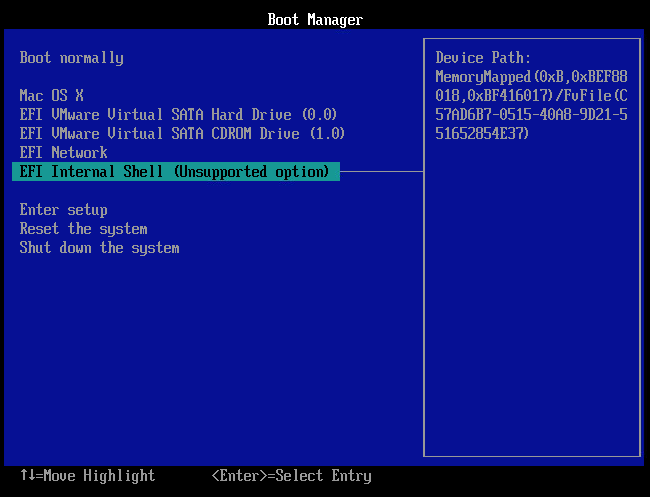Start by booting to macOS Big Sur and opening a Terminal application window. You could try entering the command given below. If the command was accepted, then SIP would be disabled on the next boot.
sudo nvram csr-active-config=%7f%00%00%00However, the command will not be accepted. Certain misspelling of will be accepted, such as in the command given below.
sudo nvram Asr-active-config=%7f%00%00%00Enter the above command, then proceed to the next step.
Shutdown macOS. In the
Settingwindow for the virtual machine, selectStartup Disk. Hold down the option key and select theRestart to Firmware…button, as shown below.Select the
EFI Internal Shell, as shown below.If desired, enter the command below to get full use of the window.
mode 128 40Set the current filesystem to the EFI volume. This should be the mapped
fs0filesystem, so you would enter the followingfs0:Next, verify the label is
EFIby entering the command below.volIf wrong, then try
fs1:,fs2:,fs3:, ....Enter the command below to save the
Asr-active-configvariable to the filecsr.bin.dmpstore Asr-active-config -s csr.binNote: For more information on this command enter
help -b dmpstore.Next, enter the command below to edit the
csr.binfile. You will need to correct the spelling by replacing the letterAwith the letterc. The can be done by typing a63over the41on the first line.hexedit csr.binThe corrected file will appear as shown below. When finished save the changes and exit.
Note: The value of the variable is stored in the last 4 bytes of this file.
Enter the command below to create the
csr-active-configvariable in NVRAM. SIP will now be disabled on the next boot of Big Sur.dmpstore -l csr.binIf desired, enter the command below to remove the
Asr-active-configvariable.dmpstore -d Asr-active-configEnter the command below to leave the command shell.
exitFrom the
Boot Manager, selectMac OS Xto boot Big Sur.
David Anderson
- 42k
- 14
- 67
- 111



